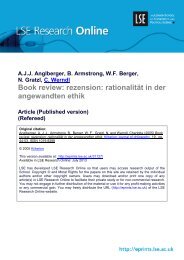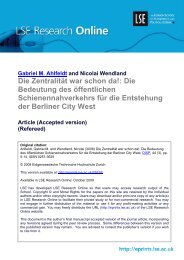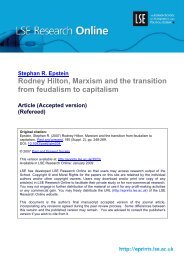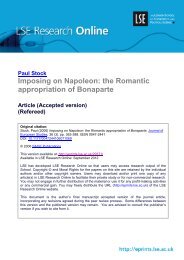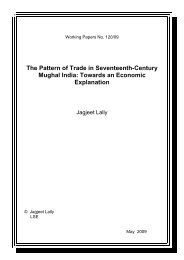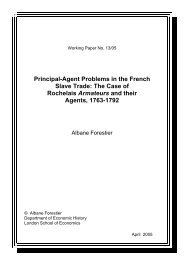Download (535Kb) - LSE Research Online - London School of ...
Download (535Kb) - LSE Research Online - London School of ...
Download (535Kb) - LSE Research Online - London School of ...
You also want an ePaper? Increase the reach of your titles
YUMPU automatically turns print PDFs into web optimized ePapers that Google loves.
Pro<strong>of</strong>. Note rst that Cum(Zq1Zq2) = E[Zq1Zq2] and Cum(Zq1Zq2Zq3) = E[Zq1Zq2Zq3]: Let<br />
a (p)<br />
j<br />
= m;1=2 qp<br />
j , p =1:::k: Then Zqp = S (p)<br />
m ; ES (p)<br />
m . From (7.14) and (7.11)<br />
max<br />
l j m ja(p)<br />
j j Cm ;1=2 log 2 m jja (p) jj2 C p =1:::k: (7.35)<br />
By diagram formalism (see e.g. Brillinger (1975), p.21), we can write<br />
ck := Cum(Zq1:::Zqk)= X<br />
Q<br />
where ; c ; denotes a subset <strong>of</strong> connected partitions =(V1:::Vk) <strong>of</strong>thetable (7.20), T ,and<br />
Q is given in (7.22). We show that<br />
where ; c 0<br />
ck = X<br />
2; c<br />
0<br />
;0 denotes the subset <strong>of</strong> connected partitions and<br />
Q 0 =<br />
mX<br />
2; c<br />
Q 0 + O(e 2<br />
m) (7.36)<br />
kY<br />
( a<br />
j1:::jk=l p=1<br />
(p)<br />
jp )q0 V1 :::q0 Vk with q 0 Vs (jp1jp2) =1fjp 1 =jp 2 gqVs(jp1jp2) forVs =((p1v2) (p2v2)).<br />
The derivations (7.26)-(7.30) imply that for any connected partition 2 ; c , Q = Q 0 +r where<br />
jr j<br />
kX<br />
pv=1:p6=v<br />
jjq Vp2 jj2jjq Vv2 jj2<br />
kY<br />
j=1:j6=pv<br />
By (7.25), jjq Vp jj2 C: With tapering, (7.28) and (7.35) imply<br />
Without tapering, from (7.30) it follows that<br />
jjq Vp jj2:<br />
jjq Vp2jj 2<br />
2 C((m=n) 2 + m ;1 log 4 m=l ;1 ) C e 2<br />
m:<br />
jjq Vp2jj 2<br />
2 C((m=n) 2 + m ;1 log 7 m) C e 2<br />
m:<br />
Thus r = O(e2<br />
m): Then (7.36) follows if we showthatQ0 = O(e2<br />
m) for 2 ; cn; c 0.<br />
In that case has at least two dierentVpVs 2V1. By the Cauchy inequality,<br />
jQ 0 j jjq Vp1jj2jjq Vs1jj2<br />
kY<br />
j=1:j6=pl<br />
jjq Vp jj2 = O(e 2<br />
m)<br />
since jjq Vp jj2 C j =1:::k and, for Vp 2V1, jjq Vp1 jj 2 2 = O(e2 m): Indeed, if Vs 2V1 then<br />
jjqVs1jj 2<br />
2 = max<br />
1 ij m ja(p) i a(p0 )<br />
j j<br />
mX<br />
j=l<br />
jqVs(j j)j Cm ;1 (log m) 4<br />
mX<br />
j=l<br />
jqVs(j j)j:<br />
With tapering, from (b) <strong>of</strong> Lemma 2.2 it follows that jqVs(j j)j Cj ;2 ,sojjq Vs1 jj 2<br />
2<br />
C e 2 m:<br />
37<br />
Cm;1 log 4 m=l ;1





